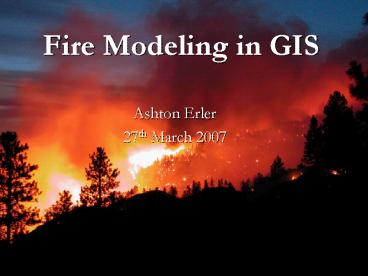Fire Modeling in GIS - PowerPoint PPT Presentation
1 / 17
Title:
Fire Modeling in GIS
Description:
Huygens Model. Cellular Automata. A Brief Summary of Cellular Automata ... Huygens Formulae is applied to the shape of the fire front, and can be ... – PowerPoint PPT presentation
Number of Views:401
Avg rating:3.0/5.0
Title: Fire Modeling in GIS
1
Fire Modeling in GIS
- Ashton Erler
- 27th March 2007
2
Why Model Forest Fires?
It roared from behind, below, and across, and the
crew, inside it, was shut out from all but a
small piece of the outside world. An Excerpt
from Young Men and Fire by Norman Maclean.
Written about the fire of Mann Gulch in Montana
(1949) that claimed the lives of no less than 13
Fire Fighters
3
Why Model Forest Fires?
- Modeling forest fires is an essential part of
forest stand management. - Modeling is essential to aiding fire fighters and
rescue workers deploy and manage fires safely.
Allowing prior warning to residents who may be in
the path of the flames and indicating the best
points to attack a fire. - Allows ecologist and forest managers to safely
plan prescribed burns, assessing the extent of
the spread of a fire. - In short it is essential to forest management and
safety!
4
Methods of Wild Fire Modeling
- There are three main methods for modeling fires,
each with their own advantages and disadvantages - Statistical (Empirical)
- Physical (Theoretical or Analytical)
- Semi-Empirical
5
Statistical Fire Modeling
- Statistical fire models predict fire spread based
on fixed probabilities collected from years of
observation. These models are usually limited to
two dimensional models and are largely only
useful for fairly uniform stands. E.g. in Canada
or Australia
6
Physical Fire Models
- These are perhaps the most intricate models, and
therefore the most accurate and sensitive.
Physical models demand a complete knowledge of
the physical properties of the system (in this
case a forest stand.) For the purposes of
modeling and GIS, the most common models used are
the semi-empirical models.
7
Semi-Empirical Models
- Semi-empirical models allow for simple
multifaceted analysis that lends itself to
developing operational tools that can be applied
across a range of situations. Most modeling
programs apply semi-empirical methods. - There are three main semi-empirical models that
are applied to fire-modeling programs in GIS - Rothermels Model Applied to programs such as
BEHAVE and FARSITE. - Huygens Model
- Cellular Automata
8
A Brief Summary of Cellular Automata
- For the remainder of this speech I will be
dealing with Rothermels and Huygens models and
the applications that have sprung from them.
However, here is a brief game to demonstrate the
principles of cellular automata. - Java Applet Cellular Automata example
9
Rothermels Equations
- Rothermel deals with with fire intensity (Ib) and
rate of spread (ROS). - Rate of Spread (ROS) Variables
- ROS steady state spread rate (meters/min)
- Reaction intensity (Kjoules burned per minute as
a function of the rate of acceleration) - Bulk density of dry (combustible) material
- Heat necessary for ignition
- Fire Intensity Variables
- Energy release per square meter of fire front (Kj
released) - Heat yield of fuel (Kj/kg)
- Mass of Fuel per unit area (kg/m2)
- Finally Rate of Spread
10
What this all Means for GIS
- These different variables are applied spatially
and temporaly to generate tabular and visual data
for fire spread. Huygens Formulae is applied to
the shape of the fire front, and can be
manipulted to take into account variables such as
slope, wind e.t.c. - And now for something completely different!
11
On to the programs
- BehavePlus (the predecessor of BEHAVE) is a
commonly used program, the most popular program
however is FARSITE and its companion program
FlamMap. - FARSITE (Fire Area Simulator) , is a seperate
executable file that uses programs such as ArcGIS
to manage spatial data.
12
FARSITE
- Farsite is used to assess
- Current Fires
- Potential Fires
- Fire Suppression
- Producing the following data
- Tabular
- Vector
- Raster
13
FlamMap
- Flam Map is an add-on to the FARSITE program
allowing the display of raster data over an
entire FARSITE landscape, removing the need for
an external GIS program for the plotting of
spatial data. It is however a less functional
program than ArcGIS. - See www.fire.org for further information
14
ArcGIS ver 9.2
- In order to deal with the all important temporal
aspect of modeling in spatial environments (not
just for fire modeling but also for weather,
urban growth e.t.c) ESRI has improved the ability
to add temporal elements to data coming into the
GIS program in their 9.2 release of Arc GIS. - This form of modelling in ArcGIS 9.2 is called
process modeling or dynamic stochastic modeling
15
Process Modeling in ArcGIS 9.2
- Process Modeling is similar to Cellular Automata
modeling, working under under logic flow chart
models using spatial analyst and advancing that
model over iterations in time. - Process
- Open Model builder in ArcGIS and create a flow
chart for the rules of fire behaviour
16
Time Modeling in ArcGIS
17
References
- http//www.esri.com/news/arcnews/fall05articles/gi
s-helping-manage2of2.html - Finney, M. A. "FARSITE Fire Area SimulatorModel
Development and Evaluation." Evaluation (1998). - Maclean, Norman. Young Men Fire. Chicago
University of Chicago Press, 1992, - Rothermel, R. C. A Mathematical Model for
Predicting Fire Spread in Wildland
FuelsIntermountain Forest Range Experiment
Station, Forest Service, US Dept. of Agriculture,
1972.































